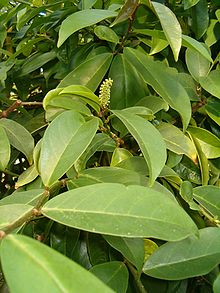- Antidesma bunius
-
Antidesma bunius Scientific classification Kingdom: Plantae (unranked): Angiosperms (unranked): Eudicots (unranked): Rosids Order: Malpighiales Family: Phyllanthaceae Tribe: Antidesmeae Genus: Antidesma Species: A. bunius Binomial name Antidesma bunius
(L.) Spreng.Antidesma bunius is a species of fruit tree in the Phyllanthaceae. It is native to Southeast Asia, the Philippines, and northern Australia. Its common Philippine name and other names include bignay, bugnay or bignai and currant tree. This is a variable plant which may be short and shrubby or tall and erect, approaching 30 meters in height. It has large oval shaped leathery evergreen leaves up to about 20 centimeters long and seven wide. They are attached to the twigs of the tree with short petioles, creating a dense canopy.
The species is dioecious, with male and female flowers growing on separate trees. The flowers have a strong, somewhat unpleasant scent. The staminate flowers are arranged in small bunches and the pistillate flowers grow on long racemes which will become the long strands of fruit. The fruits are spherical and just under a centimeter wide, hanging singly or paired in long, heavy bunches. They are white when immature and gradually turn red, then black.
Each bunch of fruits ripens unevenly, so the fruits in a bunch are all different colors. The skin of the fruit has red juice, while the white pulp has colorless juice. The fruit contains a light-colored stone. The fruit has a sour taste similar to that of the cranberry when immature, and a tart but sweet taste when ripe. This tree is cultivated across its native range and the fruits are most often used for making jam. It is often grown as a backyard fruit tree in Java.
While the majority of the indigenous population tastes bignay as sweet, people of European ancestry often find it bitter to the point of inedibility. This phenomenon is inversely linked to the taste perception of phenylthiocarbamide, and is likewise a dominant genetic trait[1].
Notes
- ^ Divergent taste responsiveness to fruit of the tree Antidesma bunius, Nature 265, 536 - 537 (10 February 1977); doi:10.1038/265536a0
External links
Wikimedia Foundation. 2010.

